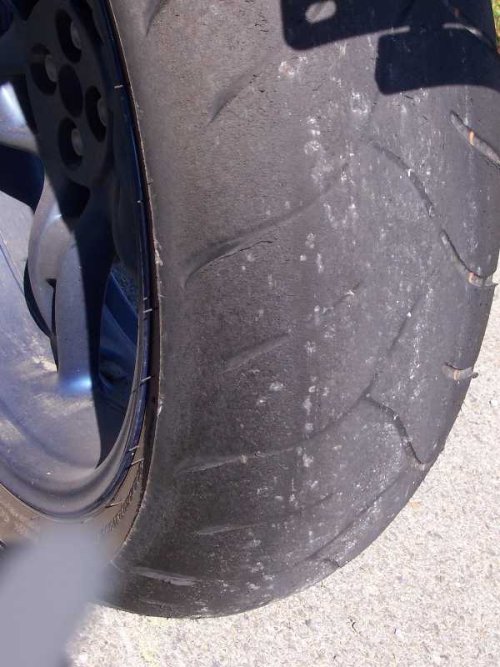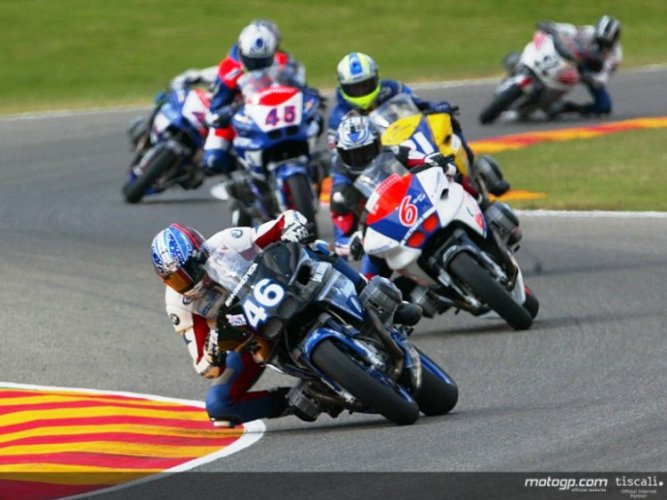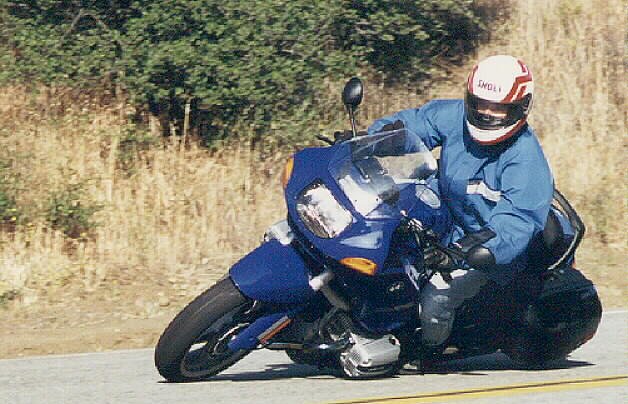Seems like good advice...
How to Break in Your New Motorcycle Tires
When it's time to replace your motorcycle tires, you'll probably notice a warning label on the new treads. Something like, “Do not assume an aggressive riding style for the first 200km, you moron.” Well, it should really be taken seriously. And there’s even a few ways you can do it faster, better and safer.
In case you're wondering, the problem stems from the manufacturing process. When pressing moulds, some manufacturers use a silicone-based release agent to keep the rubber from sticking. And if this wasn't slippery enough, the rubber itself contains special chemicals to help it flow smoothly and uniformly. All this results in a nice glossy finish, which is totally sexy until you’re sliding across the asphalt wondering what went wrong.
"Scrubbing in" is also important for longevity. Motorcycle tires are made from various materials, which are designed to work together under heat and strain. By taking it easy for the first few kilometers, you'll allow these materials to set into each other without doing any damage.
There are plenty of tips for dealing with this break-in period. Here are five of the good ones.
Don’t weave around
"If I'm scrubbing in motorcycle tires, I should swerve like a madman to generate more heat, right?"
Wrong.
I know you've seen racers do it on TV, but you’re not Valentino Rossi, are you? His treads are already scalding hot from the tire warmers, and he’s trying to keep them that way. Your motorcycle tires are cold as hell and – rather than warming them up – you’re just going to fall over.
Drive slow figure-8’s
Consider it an opportunity to re-live your Drivers-Ed youth. Find a parking lot and make slow turns, counter-leaning your body to increase the turn angle of the motorcycle. This is the safe way to scrub in the edges of your motorcycle tires. Barrelling into a corner and hoping for the best, is not.
Wait it out
When the manufacturers say 200km, they really mean it. Maybe you just bought a brand-new racing purebred, and moseying around like a frightened child isn't what you envisioned for the first ride. But be patient – dragging the pegs can wait.
I know a gung-ho goonie, who rubbed sandpaper against his motorcycle tires in an attempt to "speed up" the process. Needless to say, this is an exceptionally dimwitted idea. The geniuses at Pirelli spent countless man-hours engineering their tires to perform through specific wear patterns. An impatient bloke with some 60-grit is not what they had in mind.
Pick your battles
There’s not much point in breaking in your motorcycle tires when it’s cold and rainy out. Sure, your odometer will click closer to that 200km threshold of freedom. But your motorcycle tires won’t be much better for it.
If you can, do your purgatory time during warm, dry weather. This way, your treads will get grippier in a shorter amount of time. If you live in Vancouver – or some other subaquatic city – you might consider putting 250km on your motorcycle tires before cutting loose.
Dive in feet first
When you hit the 200km mark, don’t go peeling out of your driveway like a scalded cat.
Instead, cruise around the block until your motorcycle tires are warm to the touch. Then, feel free to cut loose a little. If there are still slippery parts on the edge of your motorcycle tires, the warmth will help you scrub them in without sliding.
We know these tips are tough to follow – getting new motorcycle tires is always going to be a bittersweet process. It’s like giving a toddler a giant chocolate bunny, and then telling him he can only nibble the ears.
But stay strong, friends! Resist eating the bunny, for now…
How to Break in Your New Motorcycle Tires
When it's time to replace your motorcycle tires, you'll probably notice a warning label on the new treads. Something like, “Do not assume an aggressive riding style for the first 200km, you moron.” Well, it should really be taken seriously. And there’s even a few ways you can do it faster, better and safer.
In case you're wondering, the problem stems from the manufacturing process. When pressing moulds, some manufacturers use a silicone-based release agent to keep the rubber from sticking. And if this wasn't slippery enough, the rubber itself contains special chemicals to help it flow smoothly and uniformly. All this results in a nice glossy finish, which is totally sexy until you’re sliding across the asphalt wondering what went wrong.
"Scrubbing in" is also important for longevity. Motorcycle tires are made from various materials, which are designed to work together under heat and strain. By taking it easy for the first few kilometers, you'll allow these materials to set into each other without doing any damage.
There are plenty of tips for dealing with this break-in period. Here are five of the good ones.
Don’t weave around
"If I'm scrubbing in motorcycle tires, I should swerve like a madman to generate more heat, right?"
Wrong.
I know you've seen racers do it on TV, but you’re not Valentino Rossi, are you? His treads are already scalding hot from the tire warmers, and he’s trying to keep them that way. Your motorcycle tires are cold as hell and – rather than warming them up – you’re just going to fall over.
Drive slow figure-8’s
Consider it an opportunity to re-live your Drivers-Ed youth. Find a parking lot and make slow turns, counter-leaning your body to increase the turn angle of the motorcycle. This is the safe way to scrub in the edges of your motorcycle tires. Barrelling into a corner and hoping for the best, is not.
Wait it out
When the manufacturers say 200km, they really mean it. Maybe you just bought a brand-new racing purebred, and moseying around like a frightened child isn't what you envisioned for the first ride. But be patient – dragging the pegs can wait.
I know a gung-ho goonie, who rubbed sandpaper against his motorcycle tires in an attempt to "speed up" the process. Needless to say, this is an exceptionally dimwitted idea. The geniuses at Pirelli spent countless man-hours engineering their tires to perform through specific wear patterns. An impatient bloke with some 60-grit is not what they had in mind.
Pick your battles
There’s not much point in breaking in your motorcycle tires when it’s cold and rainy out. Sure, your odometer will click closer to that 200km threshold of freedom. But your motorcycle tires won’t be much better for it.
If you can, do your purgatory time during warm, dry weather. This way, your treads will get grippier in a shorter amount of time. If you live in Vancouver – or some other subaquatic city – you might consider putting 250km on your motorcycle tires before cutting loose.
Dive in feet first
When you hit the 200km mark, don’t go peeling out of your driveway like a scalded cat.
Instead, cruise around the block until your motorcycle tires are warm to the touch. Then, feel free to cut loose a little. If there are still slippery parts on the edge of your motorcycle tires, the warmth will help you scrub them in without sliding.
We know these tips are tough to follow – getting new motorcycle tires is always going to be a bittersweet process. It’s like giving a toddler a giant chocolate bunny, and then telling him he can only nibble the ears.
But stay strong, friends! Resist eating the bunny, for now…









